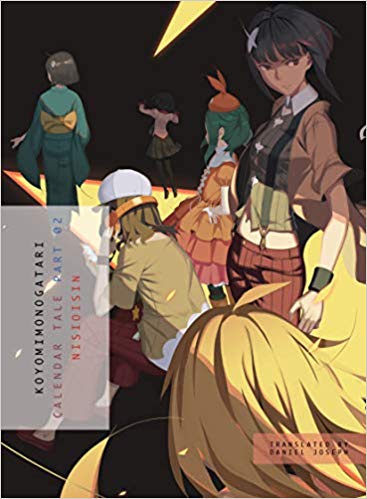By NISIOISIN and VOFAN. Released in Japan by Kodansha BOX. Released in North America by Vertical, Inc. Translated by Ko Ransom.
Yes, I know. This came out in mid-December, and here it is the following April. Part of it is that it’s still print-only (Kodansha is doing e-books for the series, but not right away), part of it is that it’s a long book even in a series with many other long books. But mostly it’s the subject matter. Monogatari in general has been a series that tends to be overdramatic and over the top, be it Araragi’s narration or the events involving a bunch of vampires, ghosts, cat demons, snake demons, devils, corpses and Senjogaharas. And, let’s face it, Ogi Oshino, who is all over this book, is not simply going to end up being Meme’s precocious niece. No, the real star of this book is a brand new character, who arrives and leaves all at the same time – Sodachi Oikura. She loves math and hates Araragi, but there’s so much more to her story than that. And it’s that story that is told here, in excruciating three-part detail.
The first story, Ogi Formula, sees Ogi at last get a proper introduction – she’s been around since the 8th book, but always after the fact; here we get the context of her meeting Araragi for the first time, and the two of them getting trapped in his old first-year classroom, which helps set up Sodachi’s story but more importantly tells us exactly how and why Araragi went from a mostly well-adjusted kid to the “I don’t need other people” guy we met in Kizumonogatari. Sodachi Riddle then shows Sodachi returning to school after a two-year absence, and (after a brief fight with Senjogahara which is probably the highlight of the book) Ogi and Araragi then go back to an abandoned house to see how he met her in middle school and had forgotten it. Then, in Sodachi Lost, after Araragi recalls he also met her even earlier… and also forgotten it… he and Hanekawa try to get Sodachi to return to school while battling her own family past and the even-more-annoying-than-usual Ogi.
The stories told here are strong, don’t get me wrong, and I liked some of the writing. The characters, though, just make me miserable. Araragi, when he’s around Ogi, is a pale shadow of his usual self, and ends up being almost as pathetic as she makes him out to be until right at the end. Ogi is designed to be thoroughly irritating, of course, but so far the series has used her sparingly – here she’s in the entire book, and we are thoroughly irritated. (Her petty rivalry with Hanekawa is probably the highlight, as it turns her smug glibness into actual childish nastiness.) And Sodachi is a child of abuse who has gone through far too much, but is also thoroughly unpleasant in very explainable ways. I can’t blame her, but I admit I’m quite happy she’s not returning. Hanekawa comes off best here… but she announces she’s leaving the country, probably to investigate Ogi, who she finds 8000% more suspicious than Araragi does.
This is a necessary book, as the series has been setting up Ogi to be the villain, and this does a whole lot to advance that. It’s also a reminder that when it comes to actual real-life issues, as opposed to oddities, there’s little Araragi can do. But man, reading this book is like eating your beets. Next time we’ll go back to that incredibly busy four-day period in August – already seen in Tsubasa Tiger, Mayoi Jiangshi, AND Shinobu Time – for the one untold story we still have – what were Kanbaru and Araragi up to back then? Fortunately, as I dawdled reading this book, I can start that one right away.




